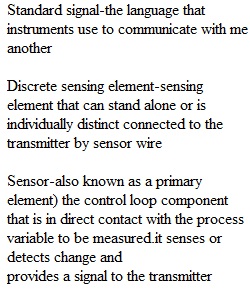


Q PROCESS INSTRUMENTATION CH. 11 TEST A. Standard signal B. Discrete sensing element C. Sensor D. Impulse tubing E. Linear scaling F. Instrument scale G. Integrally mounted sensing element H. Span I. Lower range value LRV) J. Signal converter (transducer) K. Upper range value (URV) L. Scaling 1. __sensing element that can stand alone or is individually distinct; connected to the transmitter by sensor wires. 2.__a tube that is usually made of stainless steel and allows the process variable to be sensed by the sensor located in the transmitter 3.__-a range of ordered marks that indicate the numerical values of the process variable. 4.__a sensing element that is a physical part of the transmitter 5.__-a linear relationship between two scales (input versus output) 6.__the number at the bottom of the scale. 7.__the act of equating the numerical value of one scale to its mathematically proportional value on another scale 8.__-also known as a primary element) the control loop component that is in direct contact with the process variable to be measured: it senses or detects change and provides a signal to the transmitter 9.__ part of a transmitter that converts the process variable into a standard instrument signal; a device that converts one energy form into another 10.__-a number that expresses the difference between the upper values (URV and LRV) on a scale; sometimes referred to as an operating range 11.__-the language that instruments use to communicate with me another (4 to 20 mA, 3 to 15 PSIG, or digital) 12.__-the number at the top of the scale 13. The primary role of a sensor in a control loop is the process variable. a. transmit b. transduce c. measure d. detect 14. The D/P cell transmitter converts a process variable measurement into a standard instrument a. value b. signal c. pressure d. difference e. None of the above 15. A differential pressure transmitter can be used to measure differential pressure as well as (Select all that apply.) a. temperature b. density e. rhythm d. flow rate e. level 16. The most common electronic Instrument signal used in process industries is expressed in a. millivolts b. milliamps c. pounds per square inch d. span e. range 17.What output would a transmitter produce at 75 percent of scale? a. 4 mA b. 8 mA c. 16 mA d. 20 mA 18. Calculate the span with an HRV of 225 PSIG and an LRV of 50 PSIG. 19. In order to increase production rate, a reactor set point was increased from 160 PSIG to 190 PSIG. The reactor pressure transmitter was recalibrated from 0-200 PSIG to 0-300 PSIG. What is the percent span for the new set points? a. 50 percent b. 63 percent c. 80 percent d. 90 percent 20. In a standard I/P transducer, an 8 mA input corresponds to of output? a. 4 PSIG b. 6 PSIG c. 9 PSIG d. 7.2 PSIG PreviousNext
View Related Questions